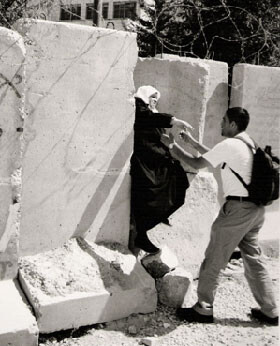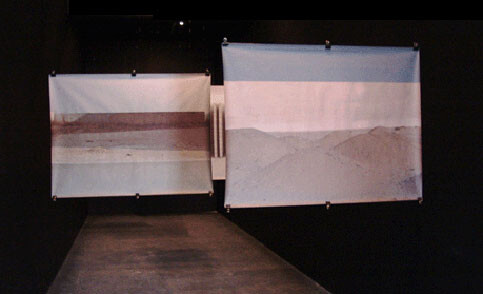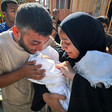The Electronic Intifada 24 April 2006

Detail from Emily Jacir’s “Where We Come From”
In the near future, it would be worth doing a follow-up exhibition to The Wall and the Checkpoints, recently shown at the Darat al Funun in Amman, Jordan, which featured Palestinian artists’ work on that theme. To the individual fresh from the borders and checkpoints of the occupied Palestinian territories, the artwork already begs to be updated, for Israel’s grip there is becoming that more tight. Indeed, it is this timeliness that gives the work a sense of urgency.
Take Palestinian-American Dana Erekat’s collection of documentary black-and-white photography. The tin-roofed, Israeli-imposed Qalandiya military checkpoint between sister cities Ramallah and Jerusalem she photographed just a few years ago has now evolved into multi-million dollar permanent structure with the friendly Israeli-dubbed name, “Atarot Crossing” (for the nearby Atarot settlement).

One of Dana Erekat’s documentary-style photographs, taken in Abu Dis
In Gaza’s overpopulated refugee camps, illustrated in the film as drab concrete houses one atop the other, children aggressively play “Israeli and Palestinians,” whereby the child imitating an Israeli soldier kicks the others and mock-shoots them in the chest. Exhibiting a similar anger, a male laborer violently dismantles a wooden structure as if it had done him personal wrong.
The newspaper-reading viewer can only imagine what those captured in the film, which was shot in 1998, are doing now that the border with Israel is hermetically sealed, and presently, not even the necessary food stocks and medicine are being allowed in. The very title of the film indicates its worth as a historical document – that all the banality of the occupation can only stew so long before the situation becomes irreversibly combustible, a warning to be heeded during the current uprising’s “period of calm.”
And one wonders whether Emily Jacir could have today attempted her work “Where We Come From,” simple in concept but genius in what it reveals about the wants and desires of a dispossessed and fractured people. The core of the work is a simple question: “If I could do anything for you anywhere in Palestine, what would it be?” to which Jacir posed to Palestinians in the West Bank and Gaza as well as the diaspora.
To Palestinians forced to live outside of their homeland, the answer is often sentimental — play football with the first child Jacir finds in Haifa, or find a family’s historic home in Jaffa (which Jacir failed to do because the home was no longer there – though the four oldest men in the city did recall the family name). For Palestinians living under the occupation, the answer was often much more practical – a Jerusalemite holding a West Bank ID (and thus prohibiting him from crossing the checkpoints west of Ramallah) living in the village of Kufr Aqab is not allowed to travel to the office where he must pay his electricity bill, and thus asks Jacir to do the chore for him. Another man holding a West Bank ID asks Jacir to go on a date with a woman from East Jerusalem with whom he has only interacted with over the phone.
Rula Halawani’s stark and foreboding photographs of Israel’s Wall are what leads one to believe that Jacir’s task would be made nearly impossible today, as movement restrictions are all the more severe.
Though her work portrays the latest physical manifestation of the Israeli occupation, Halawani’s digitally-projected black-and-white photographs have a bleak and aged quality that causes the viewer to not help but associate with news photographs from WWII. The slightly polarized photographs of the Wall give them an old film reel quality, and the slabs of the wall – one right after the other, ‘til oblivion – resemble vertical railroad tracks. In one of the images, a plume of smoke at the disappearing point of the wall’s horizon roots the association to railroads and WWII, heightening the ominous tone of the series.

Tarek al Ghoussein’s installation “Untitled A and B” series
The pull between the historic and the contemporary is also part of Tarek al Ghoussein’s related series “Untitled A and B” and his untitled self-portrait series. His photographs printed on rice paper depict mundane industrial sites. Concrete slabs anonymously populate his images, but in the context of the exhibition are associated with the much less innocuous structure straightforwardly represented in Halawani’s works. The means of the photographs’ installation – by office-supply butterfly clips and plastic filament – also refer the images to architectural planning. But the soft-edged quality of the print on the rice paper abstract the photographs and emphasize the horizon lines of the images, giving the photographs a dreamy quality and depth.
What makes al Ghoussein’s images so interesting is that many most of them could have been taken anywhere, though they indicate an ambiguous Jordan Valley landscape, lending the idea that no matter where the diaspora-born artist is, the conflict still shapes his life. As his artist’s statement explains, his work is “concerned with barriers, land, longing and, ultimately, belonging,” and how these concepts “inform, shape and define each other.”
It is these concepts — barriers, land, longing, and belonging — that solidify the exhibition, and in a way, characterize the shared Palestinian experience. Barriers, both physical and otherwise, set very difficult boundaries for Palestinians both inside and outside. For example, Western racism is wittily addressed in al Ghoussein’s self-portrait series as a faceless, stereotypical Arab dressed in black with the traditional checkered kefiyyeh wrapped around his head. And for the Palestinians, land is their shared past. Longing is their shared present — and belonging, one hopes, their shared future.
In the near future, it would be worth doing a follow-up exhibition to The Wall and the Checkpoints, recently shown at the Darat al Funun in Amman, Jordan, which featured Palestinian artists’ work on that theme. For a person fresh from the borders and checkpoints of the occupied Palestinian territories, the artwork already begs to be updated, for Israel’s grip there is becoming that more tight. Indeed, it is this timeliness that gives the work a sense of urgency.
Take Palestinian-American Dana Erekat’s collection of documentary black-and-white photography. The tin-roofed, Israeli-imposed Qalandiya military checkpoint between sister cities Ramallah and Jerusalem she photographed just a few years ago has now evolved into multi-million dollar permanent structure with the friendly Israeli-dubbed name, “Atarot Crossing” (for the nearby Atarot settlement).
The sense of urgency also arises from Rashid Mashharawi’s unembellished and unnarrated documentary film Tension, which presents a fly-on-the-wall look at “normal” life under occupation. The camera waits with the scores of Gaza laborers at Erez checkpoint, trying to reach employment in Israel. The film opens with them queuing for their IDs to be checked by young Israelis who look like they’d be more naturally placed in a mall. And quite poetically, the film — which takes the viewer through Gaza and the West Bank’s camps, settlements, and cities — closes with the Gazan workers returning at night.
In Gaza’s overpopulated refugee camps, illustrated in the film as drab concrete houses one atop the other, children aggressively play “Israeli and Palestinians,” whereby the child imitating an Israeli soldier kicks the others and mock-shoots them in the chest. Exhibiting a similar anger, a male laborer violently dismantles a wooden structure as if it had done him personal wrong.
The newspaper-reading viewer can only imagine what those captured in the film, which was shot in 1998, are doing now that the border with Israel is hermetically sealed, and presently, not even the necessary food stocks and medicine are being allowed in. The very title of the film indicates its worth as a historical document – that all the banality of the occupation can only stew so long before the situation becomes irreversibly combustible, a warning to be heeded during the current uprising’s “period of calm.”
And one wonders whether Emily Jacir could have today attempted her work “Where We Come From,” simple in concept but genius in what it reveals about the wants and desires of a dispossessed and fractured people. The core of the work is a simple question: “If I could do anything for you anywhere in Palestine, what would it be?” to which Jacir posed to Palestinians in the West Bank and Gaza as well as the diaspora.
To Palestinians forced to live outside of their homeland, the answer is often sentimental — play football with the first child Jacir finds in Haifa, or find a family’s historic home in Jaffa (which Jacir failed to do because the home was no longer there – though the four oldest men in the city did recall the family name). For Palestinians living under the occupation, the answer was often much more practical – a Jerusalemite holding a West Bank ID (and thus prohibiting him from crossing the checkpoints west of Ramallah) living in the village of Kufr Aqab is not allowed to travel to the office where he must pay his electricity bill, and thus asks Jacir to do the chore for him. Another man holding a West Bank ID asks Jacir to go on a date with a woman from East Jerusalem with whom he has only interacted with over the phone.
Rula Halawani’s stark and foreboding photographs of Israel’s Wall are what leads one to believe that Jacir’s task would be made nearly impossible today, as movement restrictions are all the more severe.
Though her work portrays the latest physical manifestation of the Israeli occupation, Halawani’s digitally-projected black-and-white photographs have a bleak and aged quality that causes the viewer to not help but associate with news photographs from WWII. The slightly polarized photographs of the Wall give them an old film reel quality, and the slabs of the wall – one right after the other, ‘til oblivion – resemble vertical railroad tracks. In one of the images, a plume of smoke at the disappearing point of the wall’s horizon roots the association to railroads and WWII, heightening the ominous tone of the series.
The pull between the historic and the contemporary is also part of Tarek al Ghoussein’s related series “Untitled A and B” and his untitled self-portrait series. His photographs printed on rice paper depict mundane industrial sites. Concrete slabs anonymously populate his images, but in the context of the exhibition are associated with the much less innocuous structure straightforwardly represented in Halawani’s works. The means of the photographs’ installation – by office-supply butterfly clips and plastic filament – also refer the images to architectural planning. But the soft-edged quality of the print on the rice paper abstract the photographs and emphasize the horizon lines of the images, giving the photographs a dreamy quality and depth.
What makes al Ghoussein’s images so interesting is that many most of them could have been taken anywhere, though they indicate an ambiguous Jordan Valley landscape, lending the idea that no matter where the diaspora-born artist is, the conflict still shapes his life. As his artist’s statement explains, his work is “concerned with barriers, land, longing and, ultimately, belonging,” and how these concepts “inform, shape and define each other.”
It is these concepts — barriers, land, longing, and belonging — that solidify the exhibition, and in a way, characterize the shared Palestinian experience. Barriers, both physical and otherwise, set very difficult boundaries for Palestinians both inside and outside. For example, Western racism is wittily addressed in al Ghoussein’s self-portrait series as a faceless, stereotypical Arab dressed in black with the traditional checkered kefiyyeh wrapped around his head. And for the Palestinians, land is their shared past. Longing is their shared present — and belonging, one hopes, their shared future.
Related Links
Based in Ramallah, Maureen Clare Murphy is Arts, Music and Culture Editor of the Electronic Intifada





